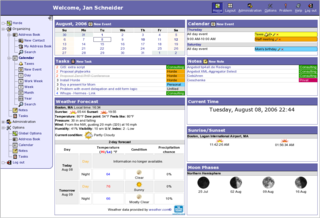
A web application is an application software that runs on a web server, unlike computer-based software programs that are stored locally on the Operating System (OS) of the device. Web applications are accessed by the user through a web browser with an active internet connection. These applications are programmed using a client–server modeled structure—the user ("client") is provided services through an off-site server that is hosted by a third-party. Examples of commonly-used, web applications, include: web-mail, online retail sales, online banking, and online auctions.

JavaServer Faces (JSF) is a Java specification for building component-based user interfaces for web applications and was formalized as a standard through the Java Community Process being part of the Java Platform, Enterprise Edition. It is also a MVC web framework that simplifies construction of user interfaces (UI) for server-based applications by using reusable UI components in a page.
XForms is an XML format used for collecting inputs from web forms. XForms was designed to be the next generation of HTML / XHTML forms, but is generic enough that it can also be used in a standalone manner or with presentation languages other than XHTML to describe a user interface and a set of common data manipulation tasks.
A user interface markup language is a markup language that renders and describes graphical user interfaces and controls. Many of these markup languages are dialects of XML and are dependent upon a pre-existing scripting language engine, usually a JavaScript engine, for rendering of controls and extra scriptability.

A server-side dynamic web page is a web page whose construction is controlled by an application server processing server-side scripts. In server-side scripting, parameters determine how the assembly of every new web page proceeds, including the setting up of more client-side processing.

Rational Application Developer for WebSphere Software (RAD) is a commercial Eclipse-based integrated development environment (IDE), made by IBM. It provides tools for visually designing, constructing, testing, analyzing, and deploying many types of applications including Java, Java EE, Web 2.0, hybrid mobile, Portal applications, and Web and REST services.
Echo is a web application framework created by the company NextApp. The latest iteration, Echo3, allows writing applications in either server-side Java or client-side JavaScript. Server-side applications do not require developer knowledge of HTML, HTTP, or JavaScript. Client-side JavaScript-based applications do not require a server, but can communicate with one via AJAX.
Smart client is a term describing a computer application environment which:

Google Web Toolkit, or GWT Web Toolkit, is an open-source set of tools that allows web developers to create and maintain JavaScript front-end applications in Java. Other than a few native libraries, everything is Java source that can be built on any supported platform with the included GWT Ant build files. It is licensed under the Apache License 2.0.
Google Developers is Google's site for software development tools, application programming interfaces (APIs), and technical resources. The site contains documentation on using Google developer tools and APIs—including discussion groups and blogs for developers using Google's developer products.

A web template system in web publishing lets web designers and developers work with web templates to automatically generate custom web pages, such as the results from a search. This reuses static web page elements while defining dynamic elements based on web request parameters. Web templates support static content, providing basic structure and appearance. Developers can implement templates from content management systems, web application frameworks, and HTML editors.
QF-Test from Quality First Software is a cross-platform software tool for the GUI test automation specialized on Java/Swing, SWT, Eclipse plug-ins and RCP applications, Java applets, Java Web Start, ULC and cross-browser test automation of static and dynamic web-based applications. Version 4.0 added Windows support for the Web browser Chrome, support for JavaFX and the AJAX frameworks jQuery UI and jQueryEasyUI were added.
Morfik Technology Pty Ltd. is an Australian software company that was acquired by Altium in 2010.
ItsNat Natural AJAX, is an open-source Java component-based Ajax framework.
A single-page application (SPA) is a web application or website that interacts with the web browser by dynamically rewriting the current web page with new data from the web server, instead of the default method of the browser loading entire new pages. The goal is faster transitions that make the website feel more like a native app.
ZK is an open-source Ajax Web application framework, written in Java, that enables creation of graphical user interfaces for Web applications with little required programming knowledge.
JWt is an open-source widget-centric web application framework for the Java programming language developed by Emweb. It has an API that uses established GUI application development patterns. The programming model is component-based and event-driven, similar to Swing.
HtmlUnit is a headless web browser written in Java. It allows high-level manipulation of websites from other Java code, including filling and submitting forms and clicking hyperlinks. It also provides access to the structure and the details within received web pages. HtmlUnit emulates parts of browser behaviour including the lower-level aspects of TCP/IP and HTTP. A sequence such as getPage(url), getLinkWith("Click here"), click allows a user to navigate through hypertext and obtain web pages that include HTML, JavaScript, Ajax and cookies. This headless browser can deal with HTTPS security, basic HTTP authentication, automatic page redirection and other HTTP headers. It allows Java test code to examine returned pages either as text, an XML DOM, or as collections of forms, tables, and links.





